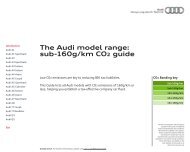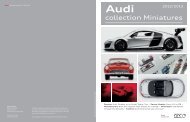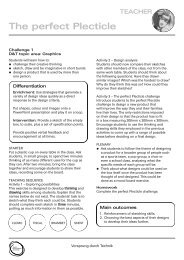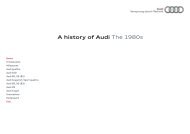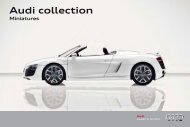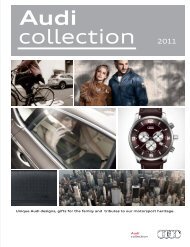The new A4 and S4 Saloon and Avant Pricing and ... - Audi
The new A4 and S4 Saloon and Avant Pricing and ... - Audi
The new A4 and S4 Saloon and Avant Pricing and ... - Audi
Create successful ePaper yourself
Turn your PDF publications into a flip-book with our unique Google optimized e-Paper software.
50<br />
CO2 data <strong>and</strong> information<br />
CO2 emissions-based Vehicle Excise Duty<br />
Vehicle Excise Duty (Road Fund Licence) is based upon the type<br />
of fuel a vehicle uses <strong>and</strong> the amount of Carbon Dioxide (CO2)<br />
it emits, measured in grams per kilometre (g/km). <strong>The</strong> DVLA has<br />
created six categories for petrol <strong>and</strong> diesel engines.<br />
CO2 emission figures<br />
<strong>The</strong> CO2 emission figures quoted in the technical data section<br />
on pages 24-27 are based on a fully laden vehicle, including the<br />
driver, <strong>and</strong> the heaviest possible options configuration. Actual<br />
CO2 emissions may be lower depending on options selected.<br />
A – up to 100g/km £0.00<br />
B – 101 to 120g/km £35.00<br />
C – 121 to 150g/km £115.00<br />
D – 151 to 165 g/km £140.00<br />
E – 166 to 185 g/km £165.00<br />
F – 186 to 225g/km £205.00<br />
G – over 226g/km £300.00<br />
Petrol <strong>and</strong> Diesel engines<br />
Servicing<br />
Servicing tailored to your needs<br />
Prior to the 2000 model year, almost all <strong>Audi</strong> models followed a<br />
traditional fixed Service Schedule similar to that of other major<br />
car manufacturers: a Lubrication Service every 10,000 miles<br />
<strong>and</strong> an Inspection Service every 12 months or 20,000 miles –<br />
whichever occurred sooner. Since then, <strong>Audi</strong> has introduced a<br />
more flexible maintenance system that works in accordance<br />
with how, where <strong>and</strong> how much an individual uses their car.<br />
<strong>The</strong> two Servicing Regimes available are the conventional<br />
‘Inspection Service Regime’ <strong>and</strong> the flexible ‘LongLife Service<br />
Regime’. When you purchase a <strong>new</strong> car, we will recommend<br />
one of these regimes to you depending on your own individual<br />
driving style <strong>and</strong> journey-type. <strong>The</strong> tables below should give<br />
you an indication of which regime might be more appropriate<br />
for you.<br />
With the LongLife Service Regime, on-board sensors<br />
continuously monitor the condition of the engine oil in terms<br />
of temperature, level & oil degradation. <strong>The</strong> monitoring system<br />
also checks mileage, brake-pad wear <strong>and</strong> battery condition.<br />
Using this information, the car’s on-board computer calculates<br />
its own maintenance interval, providing you with ample<br />
warning of a due Service via the ‘distance to Service’ display.<br />
Inspection Service Regime LongLife Service Regime<br />
Vehicle usage:<br />
Mileage Less than 10,000* miles per annum.<br />
Type of Journey Mainly city/town centre driving. Short journeys.<br />
Conditions Frequent cold starts.<br />
High engine loading – e.g. frequent hill climbs,<br />
vehicle fully loaded, towing.<br />
Driving style Uneconomical – e.g. heavy acceleration, heavy<br />
braking, constant changes in speed, constant<br />
use of high revs, ‘sporty’ driving.<br />
Service intervals:<br />
Oil-change Service Every 10,000* miles/1 year<br />
Interval Service Every 20,000* miles/2 years<br />
Interval Service Inspection Every 40,000* miles/4 years<br />
*Mileages are approximate as the Service Indicator system uses kilometres as its distance measurement.<br />
In practice, this means that every <strong>Audi</strong> gets the maintenance<br />
it needs, when it needs it. For companies <strong>and</strong> private owners<br />
alike, there are many advantages to the LongLife Service<br />
Regime. Longer service intervals mean lower maintenance<br />
costs, <strong>and</strong> thus lower whole-life costs. According to company<br />
car mileage monitored at <strong>Audi</strong> since the introduction of<br />
LongLife, petrol engines are typically achieving an average of<br />
at least 17,500 miles <strong>and</strong> diesel engines around 20,000 miles<br />
between services.<br />
One of the factors that makes this kind of servicing regime<br />
possible is the advanced engineering <strong>and</strong> technology that goes<br />
into <strong>Audi</strong> engines. Furthermore, <strong>Audi</strong> use high-grade long-life<br />
oils such as Castrol SLX LongLife III, which are designed to<br />
withst<strong>and</strong> ageing <strong>and</strong> high loads without deterioration.<br />
Compared to conventional oils, these advanced-formulation oils<br />
also give exceptional levels of engine protection, are kinder to<br />
the environment <strong>and</strong> deliver average fuel savings of 2.7%.<br />
Vehicle usage:<br />
Mileage More than 30 miles per day.<br />
Type of Journey Motorway <strong>and</strong> main road driving. Mainly longer<br />
distance journeys. Constant speeds.<br />
Conditions Normal engine loading – e.g. with little or no<br />
towing, with little or no hill climbs. Normal<br />
vehicle loading.<br />
Driving style Moderate acceleration, moderate braking,<br />
engine revs mainly below 3000.<br />
Service intervals:<br />
Interval Service Flexible to a maximum 20,000* miles/2 years<br />
Interval Service Inspection Every 40,000* miles/4 years



